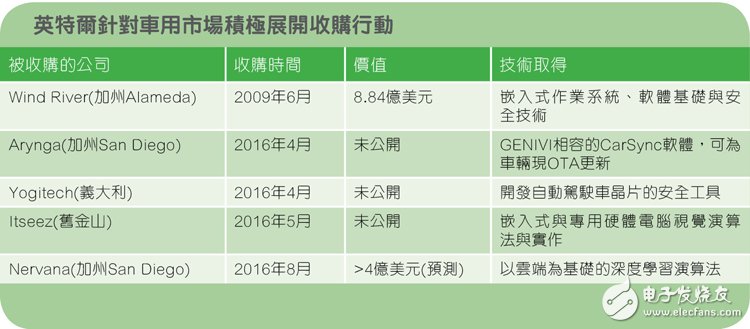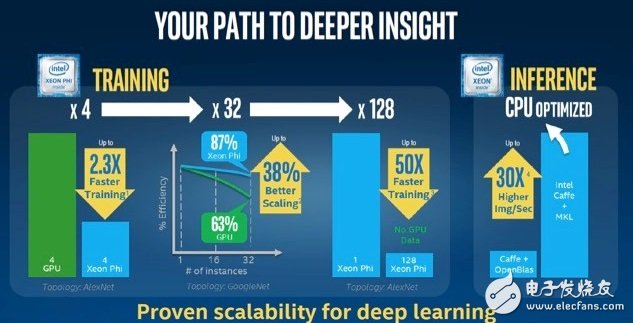Intel and Qualcomm will compete again in the automotive chip market (middle)
How will Intel enter the BMW/Intel/Mobileye Tripartite Alliance? More importantly, what specific role does Intel plan to play in this partnership? This is confirmed by the announcement of an alliance in July by three companies, including BMW, Mobileye and Intel. However, how will Intel enter this tripartite alliance? More importantly, what specific role Intel is planning to play in this partnership is still a mystery. Intel has never really figured out how it will contribute to the alliance. BMW, Mobileye and Intel announced that they will set up an industry-standard open platform for autonomous vehicles and plan to get fully automated vehicles in 2021. Just as the three partners announced an alliance, what made the analyst community curious was what chips Intel plans to bring to the new platform—especially for autonomous vehicles. Jeremy Carlson, senior analyst at IHS AutomoTIve, was amazed at Intel's participation. "Of course, we may see a platform like the Intel CPU that is a "computer" for autonomous vehicles, working with Mobileye's processors. But we Still not sure." The core issue is that Intel's chips -- no matter which one, will be paired with Mobileye's visual SoC, especially given that Mobileye recently released EyeQ5. The Israeli company announced in May this year that it plans to begin production of the EyeQ5 in 2018. This next-generation SoC is equipped with 12 Tera per second floating-point processing while maintaining less than 5W of power. Elchanan Rushinek, senior vice president of engineering at Mobileye, said his company is positioning the EyeQ5 as the central processor in the car. In addition to multiple radar and light (LIDAR), the EyeQ5 also supports more than 16 cameras, including the underlying processing of all sensors. That being the case, what role will Intel's chips play here? Caviasca did not disclose whether the new autonomous vehicles developed by the three companies use Mobileye's EyeQ4 (existing SoC designed for visual processing) or EyeQ5, but only that Mobileye is responsible for visual processing and will use the company's own camera algorithm. And combine data from multiple cameras. At the same time, Intel's chips will be used as "computing brains" to handle "multi-layer fusion" of sensing data from optical and radar. Intel's chips will work with Mobileye's visual SoC to provide cognitive engines, decision-making, and startup. Winter said that for Level 2 (partial automation) and Level 3 (conditional automation), the car needs to achieve one megabyte (TFLOPS) per second of floating-point processing power, hundreds of millions of pixels, and gigabytes of storage capacity. Before 2025, when Level 5 (fully automated) vehicles appeared, the processing demand would increase by a factor of ten, reaching billions of pixels and terabytes of storage capacity, which was sufficient for the collection and extraction of huge amounts of data. According to Intel, this mission will use Intel's Xeon family of products. However, it is not a direct Xeon CPU, but a new custom SoC that is currently under development, equipped with multiple Xeon cores and integrated hardware acceleration units. Winter emphasizes that this SoC is designed to provide "high performance computing while meeting power budgets"; therefore, it will be a automotive grade SoC and will provide functional security. Currently, Intel has not revealed when the Xeon SoC is ready. However, Caviasca pointed out during the interview, "As this product is about to enter the final production stage in 2017, we will release more relevant details." Looking at Intel's new SoC for custom cars is not enough to understand all the truth. Intel made up its mind to invest in the cloud market for connected autopilots. In August, Intel acquired Nervana Systems, a deep learning startup, to focus on artificial intelligence (AI) that the company sees as the next wave of data centers. Intel is actively pursuing acquisitions for the automotive market (Source: Intel, EE TImes) Nervana is expected to play a key role in Intel's vision of the autonomous vehicle platform. Intel will introduce Nervana's neural operations directly into its Xeon core and apply it to deep learning and transfer data to the cloud. As for the cloud data processing and server platform for performing machine learning, it combines Intel's CPU and FPGA acquisition by acquiring Altera. How does Intel position its Knights Landing Xeon Phi processor for deep learning applications? (Source: Intel) The third area is connectivity. Caviasca said that 4G capabilities have been integrated into today's in-vehicle platforms. "Intel is actively leading the 5G field," plans to use 5G for vehicle-to-base station communications, collecting data from each vehicle, transmitting it to the infrastructure for processing, and transmitting useful information back to the vehicle. Is it possible for Intel to push 802.11p/dedicated short-range communication (DSRC) technology to become the preferred wireless technology for V2V and V2X in the US? In this regard, Caviasca said, "We don't have DSRC technology, and we don't think it is good for V2X communication." Plug-in Temperature Controller Plug-In Temperature Controller,Temperature Controller Products,Plug-N-Play 6600W-30A Temperature Controller,30A Relay Temperature Controller Yuyao Huijun Electrical Appliance Co., Ltd. , https://www.yyhjdq.com
Part I: "Intel and Qualcomm will face each other again in the automotive chip market" 

